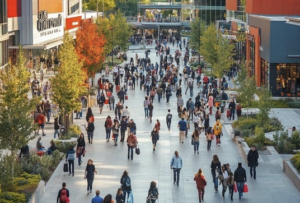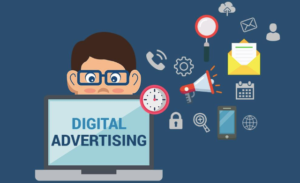Introduction
Local commerce has long been the foundation of economies, with most transactions happening in person—at local stores, restaurants, and service providers. However, as the digital world has expanded, advertising has evolved at an incredible pace, driving changes in consumer behavior. Today, the global advertising industry is on the verge of surpassing $1 trillion in revenue, while local businesses face a new set of challenges and opportunities as they navigate this increasingly digital landscape. This article explores how the advertising industry has grown, the pivotal shifts in local commerce, and the role digital advertising plays in shaping both.
The Fall of the Yellow Pages and the Rise of Digital Advertising
In the pre-digital era, the Yellow Pages dominated local advertising. Every household and business relied on it to find services, from retail to restaurants, creating a near-monopoly for local ads. But with the rise of the internet in the early 1990s, digital platforms like Google quickly displaced traditional advertising models.
The first major shift occurred in 1994 when AT&T ran the first-ever banner ad on the web. Remarkably, 44% of users who saw the ad clicked it, marking the beginning of a digital revolution. Soon after, Yahoo capitalized on this momentum by transforming from a web directory into a commercial business, pioneering keyword-based advertising and rotating banner ads.
As digital advertising grew, the Yellow Pages monopoly crumbled, unable to keep pace with the real-time, targeted capabilities of online platforms. Local businesses that had once relied on Yellow Pages listings now turned to search engines and social media to reach their customers. Today, Google has taken over that monopolistic role, controlling nearly all digital search advertising while commanding large fees from businesses looking to boost their online visibility.
The Evolution of Digital Advertising
Digital advertising has seen tremendous growth and diversification since the mid-1990s. The early days of banner ads quickly gave way to more sophisticated forms of online marketing, including pay-per-click (PPC) advertising, first pioneered in the late 1990s. These innovations allowed businesses to reach consumers in unprecedented ways, tracking behavior, preferences, and even location to deliver hyper-targeted messages.
In the 2000s, mobile advertising emerged as a new frontier. The first mobile ad appeared in 2000, when a Finnish news provider sent free news headlines via SMS. But it wasn’t until the launch of the iPhone and the App Store in 2007 and 2008, respectively, that mobile advertising truly took off. Advertisers began creating mobile-first experiences that leveraged new smartphone capabilities, such as GPS technology and in-app ads, to engage users in more personalized and interactive ways.
The explosion of mobile advertising created new challenges as well. Early mobile ads, adapted from desktop formats, were clunky and ineffective. However, advertisers quickly responded by designing mobile-first campaigns, leading to a better user experience and more impactful results. As mobile usage skyrocketed, so did ad spending in this sector.
Global Advertising Surpasses $1 Trillion
Today, the global advertising industry is set to reach historic heights. According to a 2024 forecast from GroupM, global ad revenue will grow 7.8% to nearly $990 billion this year, with expectations to surpass $1 trillion by 2025—one year earlier than predicted. This marks a monumental shift from the days when traditional media like print, radio, and TV ads dominated the market.
This rapid growth is driven by digital advertising, which now accounts for the lion’s share of total ad spend. Companies such as Google, Meta (Facebook), and Bytedance (TikTok) have come to dominate the industry, capturing vast amounts of ad revenue through their platforms, which rely heavily on artificial intelligence (AI) to optimize ad performance. By 2029, AI is expected to inform over 94% of global advertising revenue, up from 69.5% in 2024.
This transformation has also redefined advertising strategies. No longer is the product the centerpiece of ads; instead, the focus has shifted to the consumer and their problem. Modern ads are about how a product can solve a consumer’s specific need, leading to more personalized and user-centric approaches that resonate deeply with audiences.
The Role of Digital Advertising in Local Commerce
While global advertising expands at a breakneck pace, local commerce remains a key driver of economic activity, particularly in face-to-face transactions. Studies show that 80-90% of purchases are made in physical stores, with food and beverage industries leading the way. However, local businesses must now navigate an advertising landscape dominated by major tech platforms.
For local businesses, digital advertising presents both opportunities and challenges. On one hand, platforms like Google Ads and Facebook allow even the smallest businesses to target local customers with precision. On the other hand, the costs associated with these platforms can be prohibitive, especially when local businesses must compete with national or global brands for visibility. Furthermore, third-party platforms often take a substantial cut of revenue through advertising fees or transactional costs, which further erodes the profit margins of small businesses.
Platforms like GOTYOU aim to provide a solution by offering local businesses direct connections to their customers through a decentralized rewards system. By eliminating the third-party middleman, these platforms allow merchants to own their data and engage consumers in more meaningful ways, using Web3 technology to ensure that both sides retain control over their digital interactions. This approach also incentivizes consumers to promote local businesses, turning them into brand advocates.
The Future of Local Commerce and Advertising
As digital advertising continues to grow, the future of local commerce lies in how businesses adapt to these changes. The rise of AI in advertising is a significant trend that will shape how businesses of all sizes engage with consumers. AI tools enable hyper-personalized ad campaigns, ensuring that the right message reaches the right customer at the right time. For local businesses, embracing these tools could mean the difference between survival and success.
At the same time, consumer behavior is changing. As people become more aware of their digital footprints and the control large tech companies exert over their data, they are beginning to seek alternatives. This creates an opportunity for platforms that prioritize privacy and transparency, offering consumers rewards for their engagement while allowing businesses to foster authentic relationships with their customers.
Conclusion
The advertising industry has come a long way from its humble beginnings in print and television. As we look ahead, the industry is poised to surpass $1 trillion in global revenue, driven by digital and mobile advertising, AI, and the rise of platforms like Google and Meta. However, local commerce remains a vital part of the global economy. For local businesses, the challenge lies in navigating this rapidly evolving landscape, where digital advertising offers both opportunities and obstacles. By leveraging emerging technologies and embracing new platforms, local merchants can continue to thrive, even in the face of monopolistic pressures from digital giants.






